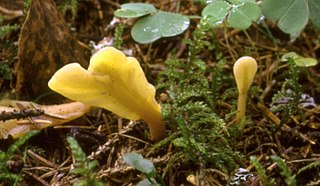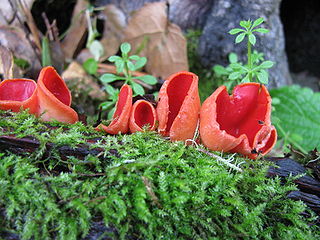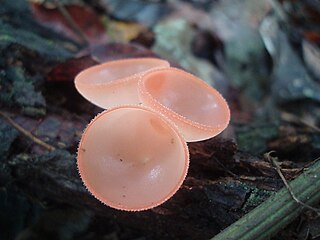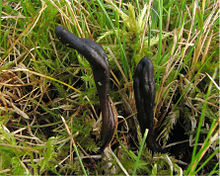
Spathularia flavida, commonly known as the yellow earth tongue, the yellow fan, or the fairy fan, is an ascomycete fungus found in coniferous forests of Asia, Europe and North America. It produces a small, fan- or spoon-shaped fruit body with a flat, wavy or lobed cream to yellow colored "head" raised on a white to cream stalk. The height is usually approximately 2–5 cm, and up to 8 cm. The fungus fruits on the ground in mosses, forest duff or humus, and fruit bodies may occur singly, in large groups, or in fairy rings. The spores produced by the fungus are needle-like, and up to 95 μm long. Several varieties have been described that differ largely in their microscopic characteristics. S. flavida has been described by authorities variously as inedible, of unknown edibility, or edible but tough.

Sarcoscypha coccinea, commonly known as the scarlet elf cup, or the scarlet cup, is a species of fungus in the family Sarcoscyphaceae of the order Pezizales. The fungus, widely distributed in the Northern Hemisphere, has been found in Africa, Asia, Europe, North and South America, and Australia. The type species of the genus Sarcoscypha, S. coccinea has been known by many names since its first appearance in the scientific literature in 1772. Phylogenetic analysis shows the species to be most closely related to other Sarcoscypha species that contain numerous small oil droplets in their spores, such as the North Atlantic island species S. macaronesica. Due to similar physical appearances and sometimes overlapping distributions, S. coccinea has often been confused with S. occidentalis, S. austriaca, and S. dudleyi.

Geoglossaceae is a family of fungi in the order Geoglossales, class Geoglossomycetes. These fungi are broadly known as earth tongues. The ascocarps of most species in the family Geoglossaceae are terrestrial and are generally small, dark in color, and club-shaped with a height of 2–8 cm. The ascospores are typically light-brown to dark-brown and are often multiseptate. Other species of fungi have been known to parasitize ascocarps. The use of a compound microscope is needed for accurate identification.

Cookeina is a genus of cup fungi in the family Sarcoscyphaceae, members of which may be found in tropical and subtropical regions of the world. Species may be found on fallen branches of angiosperms, trunks, and sometimes on fruits. The Temuans of Peninsular Malaysia are reported to use certain species from this genus as food, and also as a bait for fishing, where it is rubbed against the hook.

Geopyxis carbonaria is a species of fungus in the genus Geopyxis, family Pyronemataceae. First described to science in 1805, and given its current name in 1889, the species is commonly known as the charcoal loving elf-cup, dwarf acorn cup, stalked bonfire cup, or pixie cup. The small, goblet-shaped fruitbodies of the fungus are reddish-brown with a whitish fringe and measure up to 2 centimetres across. They have a short, tapered stalk.

Peziza praetervisa, commonly known as the purple fairy cup or the fireplace cup, is a species of fungus in the genus Peziza, family Pezizaceae. Recognized by its flattened, purple, cup-like fruitbodies, this widespread fungus typically grows scattered or in clusters on burnt ground.

Plectania nannfeldtii, commonly known as Nannfeldt's Plectania, the black felt cup, or the black snowbank cup fungus, is a species of fungus in the family Sarcosomataceae. The fruit bodies of this species resemble small, black, goblet-shaped shallow cups up to 3 cm wide, with stems up to 4 cm long attached to black mycelia. Fruit bodies, which may appear alone or in groups on the ground in conifer duff, are usually attached to buried woody debris, and are commonly associated with melting snow. Plectania nannfeldtii is found in western North America and in Asia, often at higher elevations. Similar black cup fungi with which P. nannfeldtii may be confused include Pseudoplectania vogesiaca, P. nigrella, and Helvella corium.

Trichoglossum is a genus of fungi in the family Geoglossaceae. They are commonly called hairy earth tongues. The type species is Trichoglossum hirsutum.

Trichoglossum hirsutum is a species of fungus in the family Geoglossaceae. In the UK, it has been given the recommended English name of hairy earthtongue. In North America it is known variously as velvety earth tongue, shaggy earth tongue, or black earth tongue. DNA evidence suggests the hairy earthtongue may be a species complex.

Geoglossum is a genus of fungi in the family Geoglossaceae. They are commonly called earth tongues. The type species is Geoglossum glabrum. Geoglossum species are distinguished from the related genus Trichoglossum by the lack of setae on the spore bearing surface. Geoglossum species are characterized by dark, club-shaped, terrestrial ascocarps with a fertile hymenium continuing downward from the apex of the ascocarp along the stipe, eventually intergrading with a sterile stipe. The ascospores of Geoglossum range from translucent to dark brown, and are fusiform, and multiseptate. Identification of species is based on the gross morphology of the ascocarp, color and septation of the ascospores, and shape and ornamentation of the paraphyses.

Glutinoglossum is a genus of six species of earth-tongue fungi in the family Geoglossaceae. The widespread type species, G. glutinosum, is commonly known as the "glutinous earth tongue". G. heptaseptatum is known only from the Czech Republic. Four additional species were described in 2015.

Glutinoglossum heptaseptatum is a species of earth tongue fungus in the family Geoglossaceae. Described in 2013, it is indistinguishable from its close relative G. glutinosum without the use of a microscope, and is known for certain only from the Czech Republic.

Onygena equina, commonly known as the horn stalkball, is a species of fungus in the family Onygenaceae. The fungus grows on putrefying hooves and horns, and can digest the keratin in those substrates. Fruit bodies are small and white, with thick stipes supporting a "head" shaped like a flattened sphere. The skin, or peridium, of the head appears powdery or like a white crust, and breaks open in maturity, falling off in irregular pieces to expose the pale reddish-brown powdery spores within. The fungus is known from Europe and North America.

Elias Judah Durand was an American mycologist, and botanist. He was one of the foremost American experts on the discomycetes.
Glutinoglossum exiguum is a species of earth tongue fungus that was described as new to science in 2015. It is found in Australia and New Zealand, where it grows on moss in mixed deciduous forests. The fruitbody is morphologically similar to that of Glutinoglossum australasicum, which is usually somewhat larger, more abundant, and has slightly wider and longer ascospores.

Geoglossum dunense is an earth tongue fungus in the family Geoglossaceae, described as new to science in 2015. It is known from the island of Cyprus, where it grows in coastal dunes and salt marshes under the Phoenicean juniper, but has also been documented in Malta and England following collections from diverse habitats. It produces very small fruit bodies barely exceeding 1–2 cm and has polymorphic, often moniliform paraphyses and predominantly 3-septate spores.
Pteridiospora spinosispora is a species of fungus in the class Dothideomycetes.

Stropharia caerulea, commonly known as the blue roundhead, is a species of mushroom forming fungus in the family Strophariaceae. It is a somewhat common species found in Europe and North America, where it grows as a saprophyte in meadows, roadsides, hedgerows, gardens, and woodchip mulch. S. caerulea was officially described to science in 1979, although it was known to be a distinct species for about two centuries before that. The scientific name Stropharia cyanea, as defined by Tuomikoski in 1953, and used by several later authors, is a synonym of S. caerulea.
Brunneocarpos is a fungal genus in the family Mycocaliciaceae. It is a monotypic genus, containing the single species Brunneocarpos banksiae. The fungus grows on the cones of Banksia plants in Australia.

Trichoglossum walteri is a species of fungus in the family Geoglossaceae. In its current sense, it is considered to be cosmopolitan and as such represents a complex of species worldwide. In the UK, it has been given the recommended English name of short-spored earthtongue. The European species occurs mainly in agriculturally unimproved grassland and threats to this habitat have resulted in the short-spored earthtongue being assessed as globally "vulnerable" on the IUCN Red List of Threatened Species.


















